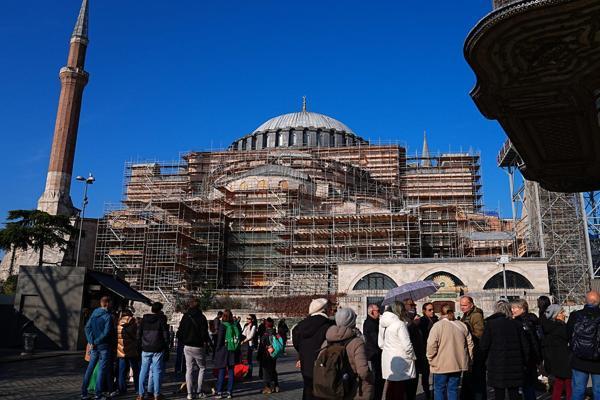Dome of Hagia Sophia to be dismantled for restoration
ISTANBUL


The iconic dome of the Hagia Sophia Mosque will be dismantled as part of an extensive restoration project aimed at preserving the historical and structural integrity of the world-renowned monument.
The effort, overseen by the Directorate General of Foundations under the Culture and Tourism Ministry, marks a critical phase in ongoing conservation work that has also addressed damaged tombs, facades and minarets.
Conducted in multiple phases, the restoration recently completed work on the Tombs of Mehmet III, Selim II and Murad III as well as the Muvakkithane Sübyan Mektebi. Now, attention has shifted to the dome, which presents unique challenges due to its intricate mosaic interior and vulnerability to environmental conditions.
“The underside of the dome is covered in mosaics, making structural intervention from below nearly impossible.” Ahmet Güleç, a member of the scientific committee for the restoration, explained. “To address this, the restoration will focus on the exterior, starting with the removal of the lead cover and cement-based materials that have caused damage over time.”
Structural irregularities in the dome’s lead covering were identified during preliminary studies. The findings necessitated plans to dismantle the dome’s outer layer and assess the condition of its structural components.
Güleç emphasized the care being taken to preserve the dome’s historical authenticity and said, “We will use materials and techniques consistent with the Ottoman-era contruction to ensure the dome is both stable and true to its original character.”
To facilitate work year-round and protect against harsh weather, a temporary roof structure will be erected above the dome. This will allow the team to proceed without interruptions from rain or wind.
The dismantling and subsequent repairs are expected to begin in March or April, following the approval of project designs by the Scientific Committee.
The restoration program also includes repairs to the north and east facades, which were found to have damage. Scaffolding made of steel pipes and safety mesh covers has been installed, and non-original cement-based plasters are being replaced with traditional Ottoman materials. Digital measurements and damage assessments are ongoing to ensure precision in repairs.
Meanwhile, the Beyazid II Minaret, partially dismantled due to structural weaknesses, is being reinforced using modern tensioners integrated into its body. Other minarets, such as the Selim II Minaret, will undergo external support installation to improve earthquake resistance.
Despite the complexity of the work, efforts are being made to minimize disruptions to visitors and worshippers.
